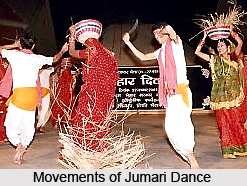 Jumari dance is one of the famous dances in the Bihar state of India. It is similar to that of "Garba performed in Gujarat" and it is a folk dance of Mithilanchal of Bihar.
Jumari dance is one of the famous dances in the Bihar state of India. It is similar to that of "Garba performed in Gujarat" and it is a folk dance of Mithilanchal of Bihar.
Performance of Jumari Dance
Jumari dance is performed only by married women, since most of the rituals are also performed by them and hence, it also signifies a good omen. After the month of Ashvin in September - October, the next one is the Kartik month and at this time, the sky becomes crystal clear, without any traces of clouds. The full moon looks attractive and spreads its milky rays in all directions. Such a romantic atmosphere gets the married women to go on dancing, singing and celebrating the turns of the season. The charming words of jumeri are - "Kartik Mas na Aakashey Badari ..." This dance is performed to express various joyous moods. The Jumari dancers wear colourful costumes and decorate themselves with jewelleries.

Harvesting Dance
Agriculture is the main source of earning livelihood in Bihar. This fact is reflected in a better way from all kinds of folk arts. Harvesting is the main field activity while farming.
During the harvesting season, male and female villagers do their work on the field along with their singing and dancing. It is believed that happiness and joy are the symbols of upcoming good harvest. Such type of dance is closely connected with the local culture and tradition.
This article is a stub. You can enrich by adding more information to it. Send your Write Up to content@indianetzone.com



















